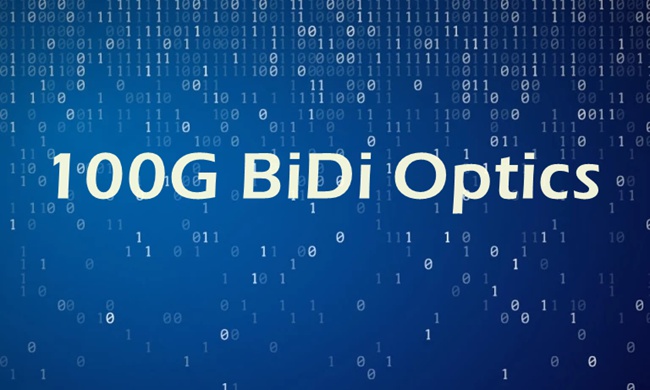Optical Transceiver
Lifting the Lid: Explaining 100G Bidirectional (BiDi) Optics
If you have ever worked with transceiver optics, you are likely to be familiar with the phrase BiDirectional (BiDi) Optics. Common BiDirectional (BiDi) optics include 1G SFP BiDi transceiver, 10G SFP+ BiDi transceiver, 10G XFP BiDi transceiver, 25G SFP28 BiDi transceiver. Nonetheless, as network speeds increase, these traditional BiDi optics can no longer keep up with the demands of high-speed data centers and IT infrastructures. So 100G BiDirectional (BiDi) Optics have been developed to satisfy these requirements. This article discusses the topic of 100G BiDi Optics.
So, what is a 100G BiDirectional (BiDi) QSFP28 Transceiver?
BiDirectional (BiDi) transmission is the most basic and original Wavelength Division Multiplexing (WDM) form. Because BiDi Optics is equipped with WDM couplers, it allows the use of two different wavelengths on the same fiber, based on the principle of combining and separating data transmitted on a single fiber based on the wavelength of the light. For customers looking to upgrade their network capacity, BiDi Transceivers provides a cost-effective solution by doubling the capacity of existing fiber infrastructure.
Datacenter traffic continues to expand as server activity increases, application density on virtualized servers increases, and the requirement for low-latency east-west communication between servers increases, necessitating the use of 100G optics. The 100G Bidirectional QSFP28 transceiver is the latest generation of BiDi Optics, which enables bi-directional optical signal transmission on a single fiber, similar to regular BiDi Optics. However, the 100G BiDi optics supports bi-directional communication at 100G speeds, allowing data center owners to maintain their existing fiber infrastructure without replacing it while doubling their transmission capacity. The bidirectional technology eliminates the need for expensive cabling modifications and safeguards operators’ investment expenditures.
100G multi-mode bidirectional (BiDi) QSFP28 optics
This 100G bidirectional transceiver provides 100Gbs bandwidth over standard duplex multi-mode fiber. The 100G multi-mode BiDi QSFP28 optics include LC duplex connectors with a transmitter and receiver that operate at full-duplex 50Gb/s across a single fiber. It is used for multi-mode fiber lines up to 70m in length (OM3) or 100m (OM4). It is appropriate for 100 Gigabit Ethernet connectivity in data centers, high-performance computing networks, enterprise core, and distribution layers, and the service provider application.
100G Singlemode bidirectional (BiDi) CWDM4 optics
The 100G Singlemode bidirectional (BiDi) optics use a single optical channel signal and operate at wavelengths of 1271nm and 1331nm. It is exclusively used as an LC simplex connector and can support two independent channels in opposite directions on a single fiber strand. It is designed to be used in inter-and intra-connect applications within and between data centers, such as between switches, routers, storage equipment, and so on. The bidirectional optics adhere to the 100G CWDM4 MSA industry standard, often supporting 10km and 40km link distances using Singlemode fiber.
100G multimode BiDi vs. 100G Singlemode BiDi vs. 10G SFP+ BiDi vs. 1G SFP+ BiDi optics, What is the difference?
| Comparison | 100G multi-mode BiDi optics | 100G Singlemode BiDi optics | 10G SFP+ BiDi Optics | 1G SFP BiDi Optics |
| Datarate | 100Gbps | 100Gbps | 10Gbps | 1Gbps |
| Formfactor | QSFP28 | QSFP28 | SFP+ | SFP |
| Fiber Connector | LC Duplex | LC Simplex | LC Simplex | LC Simplex SC Simplex |
| Fiber mode | Multimode Fiber (OM3/OM4/OM5) | Singlemode Fiber | Singlemode Fiber | Singlemode Fiber |
| Wavelength | 850nm-TX/900nm-RX 900nm-TX/850nm-RX | 1271nm,1291nm, 1311nm,1331nm | 1270nm-TX/1330nm-RX 1330nm-TX/1270nm-RX 1490nm-TX/1550nm-RX 1550nm-TX/1490nm-RX | 1310nm-TX/1550nm-RX 1550nm-TX/1310nm-RX 1310nm-TX/1490nm-RX 1490nm-TX/1310nm-RX 1490nm-TX/1550nm-RX 1550nm-TX/1490nm-RX |
| Max Distance | 70m@OM3 100m@OM4 150m@OM5 | 10km, 40km | 10km,20km,40km 80km,100km | 10km,20km,40km 80km,120km,160km |
| Standard | 100GBASE-SR-BiDi | 100GBASE-CWDM4 | 10GBASE-LR 10GBASE-ER 10GBASE-ZR 10GBASE-BX | 1000BASE-LX 1000BASE-LH 1000BASE-ZX 1000BASE-BX |
| DDM | Yes | Yes | Yes | Yes |
| Application | 100G Multimode Fiber Cabling | 100G single mode Fiber Cabling | 10G single mode Fiber Cabling | 1G single mode Fiber Cabling |
| Price | Best Expensive | Expensive | A Bit Expensive | Low |
Conclusion
100G Bidirectional optics is a rapidly growing market – The legacy Bidirectional low-speed optics can no longer genuinely meet the demands of high-speed data center traffic. By deploying 100G BiDi transceivers, data centers can effectively increase the bandwidth capacity of their fiber infrastructure, helping to achieve economic and flexible performance in optical networks. OPTCORE offers a full suite of Bidirectional (Bidi) optics solutions, including 1G BiDi optics, 2.5G SDH/SONET BiDi optics, 8G FC BiDi optics, 10G BiDi optics, 25G BiDi optics, 40G BiDi optics, 100G BiDi optics, covering from traditional SFP, XFP, to SFP28, QSFP+, QSFP28 form factor. More importantly, these BiDi optics are reliable partners with good performance, reasonable prices, and fast delivery.








In using 100G Singlemode BiDi optics, how many lanes does it use? I see when I do a show controller that there are four lanes but it only uses one. Example below:
Wavelength Tx Power Rx Power Laser Bias
Lane (nm) (dBm) (mW) (dBm) (mW) (mA)
— —– —— —— —— —— ——
0 n/a 3.4 2.1947 1.0 1.2692 82.402
1 n/a -40.0 0.0001 -40.0 0.0001 0.000
2 n/a -40.0 0.0001 -40.0 0.0001 0.000
3 n/a -40.0 0.0001 -40.0 0.0001 0.000
For the 100G singlemode BiDi optics, it usually uses single lambda, which says to convert 4x 25Gbps electrical signal (NRZ) to 1x 100Gbps (PAM4) optical signal. So your singlemode BiDi optics should have one lane on the transmitter.
We want to buy 100g bidi optics